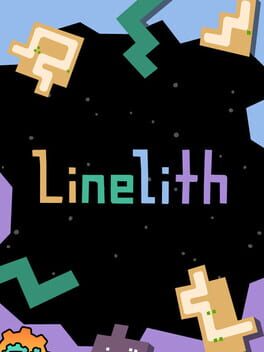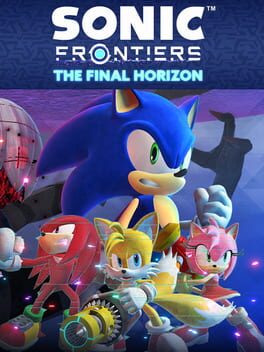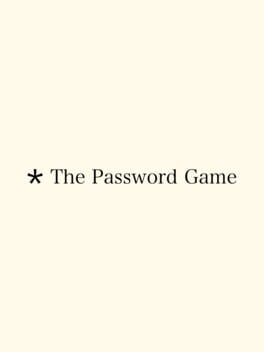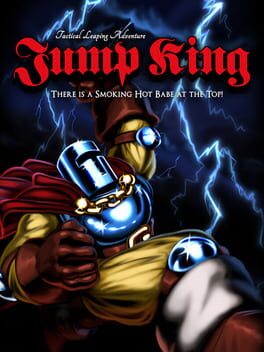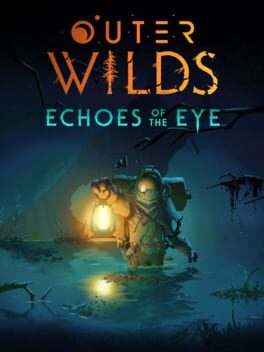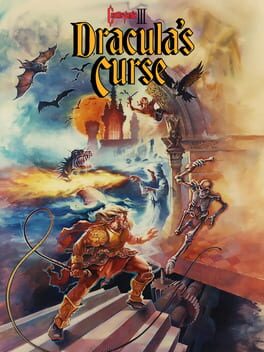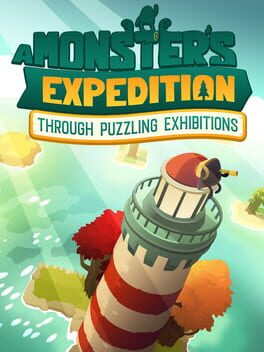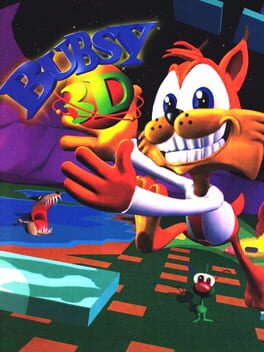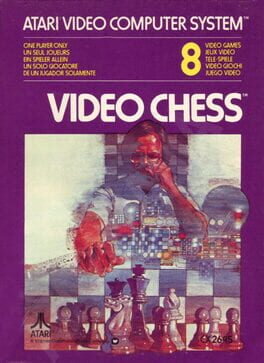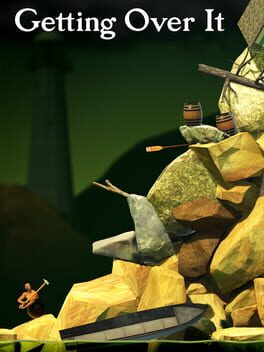Plasmatize
2022
You can beat this game in around an hour, so stop reading backloggd reviews and just play it! What's the worst that can happen? You waste $3 and 1/5 of an evening? Chances are that won't happen though, as this blend of simplicity, cleverness, and quick, intuitive, satisfying puzzles is worth every penny and every second! It's basically The Witness-esque line puzzles condensed into its most refined form. Saying any more would just spoil the fun, as the game's surprises and elegance largely speak for themselves. The very definition of short but sweet!
Disclaimer: I've only played 1 of the new Cyberspace stages so far, so I'll mainly be focusing on all the other content here. TL;DR: consider giving this DLC a shot if you liked Frontiers, but found yourself craving more of a challenge. Just be prepared to hit a lot of speed bumps on the way.
I came away from The Final Horizon with mixed, conflicting thoughts. In some ways, it’s a step in a worthy direction, with much more demanding, less-automated platforming, combat and minigame challenges that make good use of both new and old mechanics. On paper, it’s something fans have been clamouring for in modern Sonic games, and Frontiers specifically. It’s the sort of thing that could have elevated Frontiers’ formula to its full potential! But alas, we get mere glimpses of this on the horizon of a sea of minor to major annoyances.
The biggest issue putting a glass ceiling on things is simply a lack of refinement or situational considerations in general. The thing about cranking up the challenge and gameplay stakes is that, while often necessary to more deeply and richly explore game systems and mechanics, and a powerful tool to push players to do so in turn, it also brings more potential for frustration or irritation with the game if things aren’t quite as polished as they need to be. This DLC is unfortunately a victim of this effect, much more so than the (comparatively) polished and easygoing main game.
For instance, it turns Amy, Knuckles and Tails into new playable characters, but they all spend most of the runtime so poorly-equipped for combat, that you’re better off avoiding most of it to just eventually come back with Sonic, whom most of the combat still feels designed around. The exception is an unlockable ability for Tails, but it’s unlikely most players will reach this point for a good chunk of the DLC. As for platforming, these new characters are all much more slippery/sluggish/cumbersome to control compared to the inherent joy of controlling Sonic, which again, limits the excitement factor. It also occasionally leads to annoyances due to the precision required for certain challenges, though I'd say only Knuckles is substantially affected by this.
Two signature moves of his are gliding and climbing (certain) walls; both abilities get frequent use, but include needless annoyances. While gliding in the presence of objects, the camera occasionally has a tendency to be uncooperative, or swing or jump unexpectedly and throw you off course at inopportune moments. Moreover, when pressing the glide button, Knuckles strangely floats in the air for a second, as if to awkwardly “charge up” a glide. During this, Knuckles can turn verrrrrrry slowly in the air, but since gliding normally has a somewhat wide turning radius, losing height in the process, it’s often beneficial to repeatedly press and release the glide button before starting the glide to slowwwwly turn around midair. Regardless of how silly this looks, none of Knuckles’ challenges explicitly require this. However, its inclusion gives the player an opportunity to recover from minor mistakes (or of camera misbehaviour), and ample incentive to do so, only to make the process very slow and annoying to execute. Whether this was intentional tech or not, it's safe to say that either an instant turnaround from the windup, or removing the long windup altogether, would have made the whole thing feel smoother.
As for wall climbing, it also has limited turn speed; there’s a certain radius of curvature that Knuckles has to follow to change direction. What’s strange though is that moving slowly, the instinctive approach to advancing with caution/precision, doesn’t seem to decrease this radius at all. In fact, even if you stop moving completely, this radius and starting direction continues from whichever direction you were last moving. To try my best to illustrate this with just text, suppose you’re moving to the right, then stop moving to avoid an upcoming hazard. Then, after stopping, you press left to go back the way you came. Intuitively, one would expect Knuckles to climb to the left. Instead, he’ll start moving to the right, full speed, and make a little half-circle either up or down to wrap around to moving left. By now, you probably hit that hazard you stopped to avoid, and lost progress because of it. not due to insufficient skill or reflexes, but due to a quirk of the movement that makes no sense either intuitively or mechanically. There were a few sections with Knuckles where the movement/timing precision expected made this a nuisance, but in general, it just feels off.
All of these movement issues are things a player can eventually learn to avoid or work around, bringing character actions more in line with player expectations or intent, but they’re examples of how unpolished, imprecise, and even unintuitive the movement can feel, and how this hinders the game’s attempts at more difficult or precise platforming challenges. Fortunately, these issues are much less prevalent with Tails or Amy; Tails’ flight height gain delay is the only other minor example of needless sluggishness off the top of my head, and not one that tends to cause knock-on problems.
As for Sonic, he still controls just as smoothly as in the base game, and probably has the best platforming gameplay overall. This primarily takes the form of tower climbing, similar to Rhea Island from the base game, but with a cranked up challenge level. and fewer automated sections. These sections seem divisive, but I’m going to make a case for them here. As mentioned, Sonic controls very smoothly, and actually does have sufficient precision of movement to meet the demands thrown at the player, provided the player a) is cognisant of momentum, and b) masters well-timed air stomps to instantly cancel horizontal speed and land on a platform target directly below. Both of these are matters of skill, and things virtually every player can be expected to be familiar with by this point in the game, so I’d consider them reasonable demands for a challenge-focused DLC.
One common complaint about the towers is that unlike on Rhea, there are no explicit checkpoints partway up the tower to quickly get back up if you fall, but this didn’t really bother me for a few reasons. When you fall, there’s usually a chance to recover by landing on a slightly lower platform, rail, or homing target, and be back where you were in a matter of seconds. This is usually viable with sufficient skill and reflexes, and is facilitated by Sonic having two jumps, an air boost, and an extra jump out of a vertical dive, all within a single jump, providing several chances to recover or course-correct (this is also why his precision usually feels sufficient to take on the tower challenges in general). It also led to a sense that every time I fell, it was due to my own failure in either judgement or execution, with only 1 exception: there’s one particular updraft obstacle near the top of tower 4 that requires building substantial momentum, but it’s hard to foresee this being the case until you’re already in a position that’s difficult to recover from, so this one instance required a bit of punished trial and error.
Regardless, sometimes I’d slip off and screw up recovery attempts, or just not find a viable opportunity, and fall all the way down. Even in this worst case, the time to get back to the near-peak of the tower, when moving quickly, averages maybe a minute or so - this is short enough that by the time I’d reflected on where I’d fell, and what I could, should or shouldn’t do differently, I was usually a good way back to where I was. It never crossed the line where I grew impatient, while also being long enough to get re-invested in each attempt. However, I also understand that the lines for both investment and impatience differ from player to player, and other variables like mood, expectations, and intrinsic enjoyment/preference for the particular gameplay in question. So while the tower content never crossed the impatience line for me, it may well have for others. Sadly, another part of the DLC did cross that line hard for me, but more on that later.
At the top of each tower is a combat trial, and these were decent overall, outside the last one, but again, more on that later. Typically these challenges involve defeating a wave of enemies within a time limit, often with additional restrictions. Some are easy, while others demand basic strategy and skillful, efficient execution, though not so tight that the focus shifts to ultra-perfectionism. They’re a small, solid inclusion that adds to the DLC’s overall gameplay variety. The same can be said for open-zone combat, of which there isn't much new - 2 variants on prior bosses, and 2 new ones - but they put on an okay showing.
Sonic can also access a number of new cyberspace stages, but as mentioned, I've pnly played 1 so far, so I can't comment much. The stage I did play was overambitious with its layout, with numerous branching paths that had little rhyme or reason, seemingly included just for the sake of adding more paths, extra noise to parse while routing speedruns, and to ratchet up the “challenge” (i.e. busywork) of the level’s overemphasis on thorough scavenger hunts instead of speed platforming. I found the whole thing rather tedious, but in due fairness, this could be an outlier, so I’ll reserve judgement on the rest.
Speaking of tedium though... the DLC sort of tanks at the end. This begins with what’s essentially a boss rush of the first 3 Super Sonic battles, but on a tight overall time limit, and where the game’s parry mechanic, that’s repeatedly required to beat the bosses, suddenly requiring very precise timing, where previously none was needed. This timing window is difficulty-dependent, but I expect most people at this point will be on either Hard or Extreme, since the main story’s true boss was difficulty-locked. On one hand, being pushed to master parry timing against each attack, as well as find and execute super efficient strategies for these fights, can be exciting. It gave me a greater appreciation for the featured fights compared to the main game, where none of this was necessary. It gave me, at times, that thrill of facing daunting stakes and impossible odds, and giving your all to eventually overcome it, said thrill being a core reason many people seek challenge in games to begin with.
But at the same time, not only does this insane difficulty mountain come completely out of nowhere, but getting good/knowledgeable enough to clear it is a needlessly tedious process. There’s no convenient way to practice each individual fight, and no way at all to practice the new parry timing, except to just keep trying the boss rush repeatedly... which means several minutes of cinematics and trivial or already-mastered autopilot gameplay, with no changes run to run, just to get another one or two attempts at whatever phase or attack was actually giving you trouble. This, repeatedly, for hours, or however long it takes one to grind the whole thing out. It sucks, not because it’s hard, but because it’s tedious. However, there were potential ways to improve this without sacrificing the integrity of the challenge.
If you’re going to have players spend much of their time repeating sections of content, whether for stakes/tension, re-investment time after failure/retry, or simply to facilitate longer units of challenge rewarding consistency instead of one-time flukes, it’s advised to put some effort into making these replays as engaging as possible. Many contemporaries achieve this through various means, such as continual incentive to refine/improve/switch strategy (eg. conserving finite resources to help with a difficult part later), meaningful changes between runs (eg. roguelike random elements), using game feel and catharsis to make the mere process of playing as intrinsically satisfying as possible (countless examples, Pizza Tower being a great recent one), and so on. This DLC features little such engagement, especially once you’ve nailed a quick strategy for boss 1 or whatever, but could substantially improve on this by simply giving an option somewhere - anywhere - to practice each boss or boss stage individually, with no extra fluff, and parry timing requirements enabled. Then a player could reattempt the challenge whenever they felt ready. Another option would be to remove the (lengthy) non-Super Sonic sections of the challenge where the time limit is paused/doesn’t apply, as these are largely trivial and do little more than waste time on each attempt. Doing both of these would have cut out nearly all of the autopilot grind, while fully preserving the difficulty and the most relevant stakes of the boss rush itself. It could have become my favourite part of the DLC, if not the whole game. As is, the whole thing tested my patience, but there is a partial out: on Easy or Medium difficulty, you can just spam the parry buttons and it’ll likely work. This won’t totally fix the grind, and renders parry timing challenges moot, but at the very least, boss strategizing, the most interesting aspect, is preserved.
Once you finally get past this though, you can fight the final boss! ...It’s alright. Somewhat better than the main game in terms of visceral spectacle and narrative payoff, but somewhat weaker mechanically. Where the original final battle successfully tested your skill on, granted, side mechanics that didn’t really relate to the main gameplay loop, the DLC finale instead involves a lot of “try stuff until you find what less-than-intuitive thing works”, or just QTEs/doing what the game prompts you to. These aren’t huge issues in moderation, but here, it’s almost all there is. In addition, one of the required actions is made needlessly cryptic by suddenly requiring a simple but semi-obscure target-switching ability that’s always been there, but that the game never gets around to explaining, nor does anything prior nudge you into discovering it in my experience. In the interest of balance, there is one notable skill element in the use of timed parries, but unlike the prior boss rush, this isn’t really necessary to win the fight given the stats you’ll likely have by this point. It at best gives you more time to experiment between attempts, though the retry process is already mercifully short regardless. Bottom line, it feels, gameplay-wise, inadequate for a final challenge, and if the fight is instead meant to serve as more of a victory lap/grand finishing spectacle, then the trial and error elements interrupt this to the point of being less effective than it could have been.
Ultimately, The Final Horizon feels even more experimental than the base game. A few of these experiments worked, a few didn’t, and all the rest, with more time in the flask, or more careful and considered setup, had the potential to be something far greater than they were. I hope the rocky results and reception of this DLC don’t discourage Sonic Team from continuing to build on the Frontiers formula, but rather, to take all this time in the game design science lab, analyze the results for what worked, didn’t work, or just needs tweaking, and creates a more refined concoction for next time.
I came away from The Final Horizon with mixed, conflicting thoughts. In some ways, it’s a step in a worthy direction, with much more demanding, less-automated platforming, combat and minigame challenges that make good use of both new and old mechanics. On paper, it’s something fans have been clamouring for in modern Sonic games, and Frontiers specifically. It’s the sort of thing that could have elevated Frontiers’ formula to its full potential! But alas, we get mere glimpses of this on the horizon of a sea of minor to major annoyances.
The biggest issue putting a glass ceiling on things is simply a lack of refinement or situational considerations in general. The thing about cranking up the challenge and gameplay stakes is that, while often necessary to more deeply and richly explore game systems and mechanics, and a powerful tool to push players to do so in turn, it also brings more potential for frustration or irritation with the game if things aren’t quite as polished as they need to be. This DLC is unfortunately a victim of this effect, much more so than the (comparatively) polished and easygoing main game.
For instance, it turns Amy, Knuckles and Tails into new playable characters, but they all spend most of the runtime so poorly-equipped for combat, that you’re better off avoiding most of it to just eventually come back with Sonic, whom most of the combat still feels designed around. The exception is an unlockable ability for Tails, but it’s unlikely most players will reach this point for a good chunk of the DLC. As for platforming, these new characters are all much more slippery/sluggish/cumbersome to control compared to the inherent joy of controlling Sonic, which again, limits the excitement factor. It also occasionally leads to annoyances due to the precision required for certain challenges, though I'd say only Knuckles is substantially affected by this.
Two signature moves of his are gliding and climbing (certain) walls; both abilities get frequent use, but include needless annoyances. While gliding in the presence of objects, the camera occasionally has a tendency to be uncooperative, or swing or jump unexpectedly and throw you off course at inopportune moments. Moreover, when pressing the glide button, Knuckles strangely floats in the air for a second, as if to awkwardly “charge up” a glide. During this, Knuckles can turn verrrrrrry slowly in the air, but since gliding normally has a somewhat wide turning radius, losing height in the process, it’s often beneficial to repeatedly press and release the glide button before starting the glide to slowwwwly turn around midair. Regardless of how silly this looks, none of Knuckles’ challenges explicitly require this. However, its inclusion gives the player an opportunity to recover from minor mistakes (or of camera misbehaviour), and ample incentive to do so, only to make the process very slow and annoying to execute. Whether this was intentional tech or not, it's safe to say that either an instant turnaround from the windup, or removing the long windup altogether, would have made the whole thing feel smoother.
As for wall climbing, it also has limited turn speed; there’s a certain radius of curvature that Knuckles has to follow to change direction. What’s strange though is that moving slowly, the instinctive approach to advancing with caution/precision, doesn’t seem to decrease this radius at all. In fact, even if you stop moving completely, this radius and starting direction continues from whichever direction you were last moving. To try my best to illustrate this with just text, suppose you’re moving to the right, then stop moving to avoid an upcoming hazard. Then, after stopping, you press left to go back the way you came. Intuitively, one would expect Knuckles to climb to the left. Instead, he’ll start moving to the right, full speed, and make a little half-circle either up or down to wrap around to moving left. By now, you probably hit that hazard you stopped to avoid, and lost progress because of it. not due to insufficient skill or reflexes, but due to a quirk of the movement that makes no sense either intuitively or mechanically. There were a few sections with Knuckles where the movement/timing precision expected made this a nuisance, but in general, it just feels off.
All of these movement issues are things a player can eventually learn to avoid or work around, bringing character actions more in line with player expectations or intent, but they’re examples of how unpolished, imprecise, and even unintuitive the movement can feel, and how this hinders the game’s attempts at more difficult or precise platforming challenges. Fortunately, these issues are much less prevalent with Tails or Amy; Tails’ flight height gain delay is the only other minor example of needless sluggishness off the top of my head, and not one that tends to cause knock-on problems.
As for Sonic, he still controls just as smoothly as in the base game, and probably has the best platforming gameplay overall. This primarily takes the form of tower climbing, similar to Rhea Island from the base game, but with a cranked up challenge level. and fewer automated sections. These sections seem divisive, but I’m going to make a case for them here. As mentioned, Sonic controls very smoothly, and actually does have sufficient precision of movement to meet the demands thrown at the player, provided the player a) is cognisant of momentum, and b) masters well-timed air stomps to instantly cancel horizontal speed and land on a platform target directly below. Both of these are matters of skill, and things virtually every player can be expected to be familiar with by this point in the game, so I’d consider them reasonable demands for a challenge-focused DLC.
One common complaint about the towers is that unlike on Rhea, there are no explicit checkpoints partway up the tower to quickly get back up if you fall, but this didn’t really bother me for a few reasons. When you fall, there’s usually a chance to recover by landing on a slightly lower platform, rail, or homing target, and be back where you were in a matter of seconds. This is usually viable with sufficient skill and reflexes, and is facilitated by Sonic having two jumps, an air boost, and an extra jump out of a vertical dive, all within a single jump, providing several chances to recover or course-correct (this is also why his precision usually feels sufficient to take on the tower challenges in general). It also led to a sense that every time I fell, it was due to my own failure in either judgement or execution, with only 1 exception: there’s one particular updraft obstacle near the top of tower 4 that requires building substantial momentum, but it’s hard to foresee this being the case until you’re already in a position that’s difficult to recover from, so this one instance required a bit of punished trial and error.
Regardless, sometimes I’d slip off and screw up recovery attempts, or just not find a viable opportunity, and fall all the way down. Even in this worst case, the time to get back to the near-peak of the tower, when moving quickly, averages maybe a minute or so - this is short enough that by the time I’d reflected on where I’d fell, and what I could, should or shouldn’t do differently, I was usually a good way back to where I was. It never crossed the line where I grew impatient, while also being long enough to get re-invested in each attempt. However, I also understand that the lines for both investment and impatience differ from player to player, and other variables like mood, expectations, and intrinsic enjoyment/preference for the particular gameplay in question. So while the tower content never crossed the impatience line for me, it may well have for others. Sadly, another part of the DLC did cross that line hard for me, but more on that later.
At the top of each tower is a combat trial, and these were decent overall, outside the last one, but again, more on that later. Typically these challenges involve defeating a wave of enemies within a time limit, often with additional restrictions. Some are easy, while others demand basic strategy and skillful, efficient execution, though not so tight that the focus shifts to ultra-perfectionism. They’re a small, solid inclusion that adds to the DLC’s overall gameplay variety. The same can be said for open-zone combat, of which there isn't much new - 2 variants on prior bosses, and 2 new ones - but they put on an okay showing.
Sonic can also access a number of new cyberspace stages, but as mentioned, I've pnly played 1 so far, so I can't comment much. The stage I did play was overambitious with its layout, with numerous branching paths that had little rhyme or reason, seemingly included just for the sake of adding more paths, extra noise to parse while routing speedruns, and to ratchet up the “challenge” (i.e. busywork) of the level’s overemphasis on thorough scavenger hunts instead of speed platforming. I found the whole thing rather tedious, but in due fairness, this could be an outlier, so I’ll reserve judgement on the rest.
Speaking of tedium though... the DLC sort of tanks at the end. This begins with what’s essentially a boss rush of the first 3 Super Sonic battles, but on a tight overall time limit, and where the game’s parry mechanic, that’s repeatedly required to beat the bosses, suddenly requiring very precise timing, where previously none was needed. This timing window is difficulty-dependent, but I expect most people at this point will be on either Hard or Extreme, since the main story’s true boss was difficulty-locked. On one hand, being pushed to master parry timing against each attack, as well as find and execute super efficient strategies for these fights, can be exciting. It gave me a greater appreciation for the featured fights compared to the main game, where none of this was necessary. It gave me, at times, that thrill of facing daunting stakes and impossible odds, and giving your all to eventually overcome it, said thrill being a core reason many people seek challenge in games to begin with.
But at the same time, not only does this insane difficulty mountain come completely out of nowhere, but getting good/knowledgeable enough to clear it is a needlessly tedious process. There’s no convenient way to practice each individual fight, and no way at all to practice the new parry timing, except to just keep trying the boss rush repeatedly... which means several minutes of cinematics and trivial or already-mastered autopilot gameplay, with no changes run to run, just to get another one or two attempts at whatever phase or attack was actually giving you trouble. This, repeatedly, for hours, or however long it takes one to grind the whole thing out. It sucks, not because it’s hard, but because it’s tedious. However, there were potential ways to improve this without sacrificing the integrity of the challenge.
If you’re going to have players spend much of their time repeating sections of content, whether for stakes/tension, re-investment time after failure/retry, or simply to facilitate longer units of challenge rewarding consistency instead of one-time flukes, it’s advised to put some effort into making these replays as engaging as possible. Many contemporaries achieve this through various means, such as continual incentive to refine/improve/switch strategy (eg. conserving finite resources to help with a difficult part later), meaningful changes between runs (eg. roguelike random elements), using game feel and catharsis to make the mere process of playing as intrinsically satisfying as possible (countless examples, Pizza Tower being a great recent one), and so on. This DLC features little such engagement, especially once you’ve nailed a quick strategy for boss 1 or whatever, but could substantially improve on this by simply giving an option somewhere - anywhere - to practice each boss or boss stage individually, with no extra fluff, and parry timing requirements enabled. Then a player could reattempt the challenge whenever they felt ready. Another option would be to remove the (lengthy) non-Super Sonic sections of the challenge where the time limit is paused/doesn’t apply, as these are largely trivial and do little more than waste time on each attempt. Doing both of these would have cut out nearly all of the autopilot grind, while fully preserving the difficulty and the most relevant stakes of the boss rush itself. It could have become my favourite part of the DLC, if not the whole game. As is, the whole thing tested my patience, but there is a partial out: on Easy or Medium difficulty, you can just spam the parry buttons and it’ll likely work. This won’t totally fix the grind, and renders parry timing challenges moot, but at the very least, boss strategizing, the most interesting aspect, is preserved.
Once you finally get past this though, you can fight the final boss! ...It’s alright. Somewhat better than the main game in terms of visceral spectacle and narrative payoff, but somewhat weaker mechanically. Where the original final battle successfully tested your skill on, granted, side mechanics that didn’t really relate to the main gameplay loop, the DLC finale instead involves a lot of “try stuff until you find what less-than-intuitive thing works”, or just QTEs/doing what the game prompts you to. These aren’t huge issues in moderation, but here, it’s almost all there is. In addition, one of the required actions is made needlessly cryptic by suddenly requiring a simple but semi-obscure target-switching ability that’s always been there, but that the game never gets around to explaining, nor does anything prior nudge you into discovering it in my experience. In the interest of balance, there is one notable skill element in the use of timed parries, but unlike the prior boss rush, this isn’t really necessary to win the fight given the stats you’ll likely have by this point. It at best gives you more time to experiment between attempts, though the retry process is already mercifully short regardless. Bottom line, it feels, gameplay-wise, inadequate for a final challenge, and if the fight is instead meant to serve as more of a victory lap/grand finishing spectacle, then the trial and error elements interrupt this to the point of being less effective than it could have been.
Ultimately, The Final Horizon feels even more experimental than the base game. A few of these experiments worked, a few didn’t, and all the rest, with more time in the flask, or more careful and considered setup, had the potential to be something far greater than they were. I hope the rocky results and reception of this DLC don’t discourage Sonic Team from continuing to build on the Frontiers formula, but rather, to take all this time in the game design science lab, analyze the results for what worked, didn’t work, or just needs tweaking, and creates a more refined concoction for next time.
2023
One of the best "troll games" I've played to date, as deviously clever as it is hilarious, all without overstaying its welcome. A simple satirical premise that rapidly escalates into a masterclass in supervillainy! All you need to do is craft a single password that meets all 35 rules, each revealed after the last is met, and it's about as straightforward as a drunk ballet dancer on a runaway merry-go-round!
Playing this is like building a taller and taller house of cards with constantly updating design specs, forcing you to keep changing critical cards' positions... and occasionally closing a drafty window that opens by itself, threatening to destroy your whole stack! Oh, and if it does, you can't just copy-paste your old design again, because some of the specs have small but critical RNG elements that make half your prior efforts useless without significant adjustments!
All of which is an elaborate way of saying that the password requirements are nothing short of evil genius! Rules and tasks continue to get more outlandish and start playing off each other in ways I can only describe as delightfully irritating! The game says, okay Mr. Smartypants, you've got roman numerals, but now you gotta make them multiply to 35. Oh, and here's a periodic table puzzle... but wait, those roman numerals are elements too! And this is just the beginning of your descent into madness. Every time you think you've seen the most ridiculous, awful, plan-destroying rule yet, something even more devilish comes along, leaving your face a palm-dipped plate of fresh laughter, organic cursing, and exasperated "NO!"s to taste!
It's the rapidly increasing complexity, pressure, and constant script-flipping plot twists that make this brain-knotting, player-teasing experience so memorable! I will never forget the rug-pull rush of seeing the last, tiny requirement, realizing its Chaotic Evil implications, and then scrambling to optimize and redesign about 10 different non-trivial pieces in under 10 minutes while keeping another 20 pieces perfectly aligned, all while constantly feeding a hungry chicken. Never in my life have I been so proud of a 101-character unintelligible monstrosity I haven't a hope of remembering!
Playing this is like building a taller and taller house of cards with constantly updating design specs, forcing you to keep changing critical cards' positions... and occasionally closing a drafty window that opens by itself, threatening to destroy your whole stack! Oh, and if it does, you can't just copy-paste your old design again, because some of the specs have small but critical RNG elements that make half your prior efforts useless without significant adjustments!
All of which is an elaborate way of saying that the password requirements are nothing short of evil genius! Rules and tasks continue to get more outlandish and start playing off each other in ways I can only describe as delightfully irritating! The game says, okay Mr. Smartypants, you've got roman numerals, but now you gotta make them multiply to 35. Oh, and here's a periodic table puzzle... but wait, those roman numerals are elements too! And this is just the beginning of your descent into madness. Every time you think you've seen the most ridiculous, awful, plan-destroying rule yet, something even more devilish comes along, leaving your face a palm-dipped plate of fresh laughter, organic cursing, and exasperated "NO!"s to taste!
It's the rapidly increasing complexity, pressure, and constant script-flipping plot twists that make this brain-knotting, player-teasing experience so memorable! I will never forget the rug-pull rush of seeing the last, tiny requirement, realizing its Chaotic Evil implications, and then scrambling to optimize and redesign about 10 different non-trivial pieces in under 10 minutes while keeping another 20 pieces perfectly aligned, all while constantly feeding a hungry chicken. Never in my life have I been so proud of a 101-character unintelligible monstrosity I haven't a hope of remembering!
2022
A solid one-off horror experience. Preys on several primal fears. Knows how to leverage the unknown to build tension and anxiety. Immersion is a key goal here, so after a brief introductory period, almost everything is diegetic. This combined with less-is-more use of sound effects and an ever-increasing sense of urgency help maintain one's full attention.
Gameplay is mechanically simple, but there's just enough safety-versus-speed strategizing and slowly escalating uncertainty/demand for precision to keep the pressure on. A single mistake means death as you navigate a fragile submarine with naught but three numbers, an incomplete map, and a very limited radar. It all had me on edge, particularly near the end.
This game works best the first time through, when you don't know which elements are scripted versus organic. Similarly, the context and what passes for a story are both unsettling, but fairly one-and-done ordeals. Still, some of the imagery and steadily bubbling panic moments will definitely stick with me! An easy recommendation if you've got an hour to kill.
Gameplay is mechanically simple, but there's just enough safety-versus-speed strategizing and slowly escalating uncertainty/demand for precision to keep the pressure on. A single mistake means death as you navigate a fragile submarine with naught but three numbers, an incomplete map, and a very limited radar. It all had me on edge, particularly near the end.
This game works best the first time through, when you don't know which elements are scripted versus organic. Similarly, the context and what passes for a story are both unsettling, but fairly one-and-done ordeals. Still, some of the imagery and steadily bubbling panic moments will definitely stick with me! An easy recommendation if you've got an hour to kill.
2019
Spoiler-free recommendation: Echoes of the Eye is great! Not quite as amazing as base Outer Wilds, but that really just reflects how unreachably high that bar is. Some gameplay grievances aside, it successfully recaptures the base game’s feelings of awe and excitement with each new discovery, the general progression design, the creativity, the tangible sense of culture and purpose within its world, and the ever-present intrigue. In some respects, it may even surpass the base game. And it achieves all this without feeling at all like a rehash.
-----SPOILERS FROM THIS POINT ONWARD-----
The DLC is basically a massive, intricate puzzle box built around a similar inverted-tree trail of clues to the base game, meaning lots of places to go at first in any order, each with intriguing and useful information, gradually converging into fewer, bigger steps and reveals scattered across locations new and old, until everything reaches the final puzzle and answers to the overarching mystery. Compared to Outer Wilds proper though, there are far fewer, but far longer, discover trails to traverse. While "progress bottleneck" points are still unlikely until right near the end, this is a more single-threaded experience than the broad, free-roaming exploration of the main game, and as such, is likely to play out more similarly across different people's playthroughs.
The DLC is set within a single, complex, self-contained rotating space station functionally isolated from the main game, filled with completely new mechanics and a focus on visual clues rather than written ones (the slideshow/visions aspects were awesome!) There’s a surprising amount of content packed into this one location; it could take almost as long as the main game to fully complete. I was amazed how deep the rabbit hole went, and how many times there was some big trick or hidden area that was apparently there all along, but only revealed/hinted at many hours in. Secrets within secrets within secrets within secrets within secrets, all hidden just out of the player’s grasp with careful, subtle sleight of hand. Even the station itself was like “yeah, this DLC place has always been here, just hidden outside the planetary plane behind a cloaking device that was only now spotted due to a lucky accident.” That was really cool. And I loved the way it tied into the main game’s lore, especially the eye's signal!
The main things stopping EotE from quite reaching the main game’s level for me are 1) many central mechanics, the narrative and its answers being slightly less conceptually thrilling compared to the main game (though still very interesting), and 2) the time loop aspect not being used quite as well as in the main game. Sure, the breaking dam was a memorable moment, with a few cool implications (the musical cabin puzzle was genius!) Sure, it still creates a sense of urgency that will appeal to some and turn off others. But in this case, the loop also adds somewhat lengthy, repetitive trips with each loop, to first get back to the station, then travel for a bit along the same river to grab an artifact, then to whatever campfire you want to sleep at, and possibly a bit of slowly walking or rafting through familiar dream world territory as well. This starts to become an issue with the dream world movement system in particular feels a lot more restrictive and less exciting than the wild jetpack parkour common throughout the main game, and parts of EotE's not-dream world. It's understandable that the jetpack was removed for the dream puzzles and stealth sections to work, but repeatedly traversing these sections loses its luster once the initial tension and mystique starts to wear off. By comparison, the return trips in the rest of Outer Wilds were usually fairly short - just long enough to reflect and let things sink in between discoveries. Locations changed constantly so the trips varied greatly after the brief initial ship ride. Meanwhile, in EotE's latter half, you can easily end up repeating more or less the same, several minutes long, "brain on autopilot" process about a dozen times. It’s far from a deal breaker, but combined with the more restrictive movement, it does kill the game's momentum just a touch toward the end.
Even so, this remains a meaty and more than worthy chunk of additional Outer Wilds content. I thoroughly enjoyed my time with it, and I eagerly await whatever wild worlds Mobius Digital cook up next!
-----SPOILERS FROM THIS POINT ONWARD-----
The DLC is basically a massive, intricate puzzle box built around a similar inverted-tree trail of clues to the base game, meaning lots of places to go at first in any order, each with intriguing and useful information, gradually converging into fewer, bigger steps and reveals scattered across locations new and old, until everything reaches the final puzzle and answers to the overarching mystery. Compared to Outer Wilds proper though, there are far fewer, but far longer, discover trails to traverse. While "progress bottleneck" points are still unlikely until right near the end, this is a more single-threaded experience than the broad, free-roaming exploration of the main game, and as such, is likely to play out more similarly across different people's playthroughs.
The DLC is set within a single, complex, self-contained rotating space station functionally isolated from the main game, filled with completely new mechanics and a focus on visual clues rather than written ones (the slideshow/visions aspects were awesome!) There’s a surprising amount of content packed into this one location; it could take almost as long as the main game to fully complete. I was amazed how deep the rabbit hole went, and how many times there was some big trick or hidden area that was apparently there all along, but only revealed/hinted at many hours in. Secrets within secrets within secrets within secrets within secrets, all hidden just out of the player’s grasp with careful, subtle sleight of hand. Even the station itself was like “yeah, this DLC place has always been here, just hidden outside the planetary plane behind a cloaking device that was only now spotted due to a lucky accident.” That was really cool. And I loved the way it tied into the main game’s lore, especially the eye's signal!
The main things stopping EotE from quite reaching the main game’s level for me are 1) many central mechanics, the narrative and its answers being slightly less conceptually thrilling compared to the main game (though still very interesting), and 2) the time loop aspect not being used quite as well as in the main game. Sure, the breaking dam was a memorable moment, with a few cool implications (the musical cabin puzzle was genius!) Sure, it still creates a sense of urgency that will appeal to some and turn off others. But in this case, the loop also adds somewhat lengthy, repetitive trips with each loop, to first get back to the station, then travel for a bit along the same river to grab an artifact, then to whatever campfire you want to sleep at, and possibly a bit of slowly walking or rafting through familiar dream world territory as well. This starts to become an issue with the dream world movement system in particular feels a lot more restrictive and less exciting than the wild jetpack parkour common throughout the main game, and parts of EotE's not-dream world. It's understandable that the jetpack was removed for the dream puzzles and stealth sections to work, but repeatedly traversing these sections loses its luster once the initial tension and mystique starts to wear off. By comparison, the return trips in the rest of Outer Wilds were usually fairly short - just long enough to reflect and let things sink in between discoveries. Locations changed constantly so the trips varied greatly after the brief initial ship ride. Meanwhile, in EotE's latter half, you can easily end up repeating more or less the same, several minutes long, "brain on autopilot" process about a dozen times. It’s far from a deal breaker, but combined with the more restrictive movement, it does kill the game's momentum just a touch toward the end.
Even so, this remains a meaty and more than worthy chunk of additional Outer Wilds content. I thoroughly enjoyed my time with it, and I eagerly await whatever wild worlds Mobius Digital cook up next!
2019
Hypothesis: Outer Wilds is a masterpiece.
Unfortunately, testing this hypothesis is almost impossible without spoilers. This is a game you can only really experience once, and giving any details or specific examples inherently takes away from said experience, since it's a game so purely about discovery and understanding of the game's universe. Hence why so many people wish they could forget everything about it and play it again; why so many rave about the game, yet stubbornly refuse to elaborate.
So without getting into specifics yet, here's my spoiler-free recommendation:
If you love exploration games, cool sci-fi concepts, Groundhog Day-type setups, or if knowledge-based progression appeals to you, you owe it to yourself to play this knowing as little as possible. For some super high-level stuff, the visual aesthetics and soundtrack are both very nice and compliment the experience well, and I really loved the story, how it was told, and its synergy with a phenomenal gameplay loop. Approach the game with curiosity, and give it an hour or two to see what it's all about.
-----SPOILERS FROM THIS POINT FORWARD!-----
For all its intricate brilliances, I think something central to what makes Outer Wilds so incredible is surprisingly straightforward: it has one of the coolest, most imaginative and fascinating video game worlds I’ve ever seen! Like, just absolutely full of the most awesome ideas for planets/locations, incorporations of science, the life forms and their distinct cultures, customs, technology, ways of communicating, the central mysteries and their answers and implications, just... all of it! So many discoveries, inferences and connections had me like “gasp Oh my god! So [hastily thinking through implications]? That’s so freaking COOL!” Even after finishing, and then watching some streamers play it, it just gets cooler the more details I pick up on!
So much of the game’s brilliance stems from this. You get some unforgettable sights and spectacles from the worlds and finding out how they work. You get ridiculously neat mechanics built around quantum observation and entanglement, or navigating multi-branched Russian nesting doll Tardis space, or traversing the underside of a collapsing hollow planet crust with a wormhole in the center. You get some super cool puzzles, discoveries and set pieces built around these worlds/rules, your knowledge of them, and the time loop setup. You get this amazing feeling of awe and intrigue from learning some awesome nugget about the in-universe rules or what the Nomai were up to, suddenly realizing what to do with that information, doing so and then finding something even cooler! It’s a constant high of wander and wonder; no game has made me so excited just to explore and discover things before! I loved every minute of it.
All of this could have been squandered, though, if not for another piece of design brilliance: the progression structure. Having progress be tied almost exclusively to your knowledge of the game’s universe, rather than typical level progression, locked doors, new abilities and so forth is already a neat concept. But the true genius I think is in the inverted-tree structure both of access to new places, and of the mysteries/narrative itself. By this I mean that you start the game at the leaves, with dozens of eye-catching places to go that pretty much all lead you to a new bit of critical knowledge or narrative context - you can go anywhere and it’s basically guaranteed you’ll find something relevant, whether lore, rules, past events, present events, clues, or even just being able to observe places like “OK so we’ve established that space is all screwy here and there are scary lightbulb fish and I have no idea where I’m going; got it!” No place is wasted or unimportant. Every leaf matters. So right from the start, there’s so much that intrigues you and drives you to keep exploring and learning, no matter which of countless possible orders each player might discover things in. It’s true free-roaming exploration, perfectly balanced with guaranteed visual and conceptual hooks, and most likely progression of some kind.
Then branches start converging with others, you see connections and new breadcrumbs, and get even more invested in pursuing those, or returning to foggy death fish land with new biological expertise you discovered 5 hours later. But as you do so, you also keep running into new leaves, since they’re all scattered between the planets (instead of, say, one planet having all the clues and answers to one mystery and little else, potentially isolating the player to one branch of what’s going on for extended periods and creating a less dynamic or interesting experience). It makes it feel like there’s always tons to explore and learn and do and try, and also makes total progress walls or bottlenecks unlikely until right near the end, where things are converging to the final answers to each major mystery and there are only a few pieces left to play with. By this point, you have a clear idea where to look, and are, hopefully, less likely to get totally lost for hours leading to excess frustration or boredom. It's inevitably still a possibility, though, due to the game's hands-off nature.
And finally, the last piece of each major mystery converges to the true ending. WOW, what an ending! Heartbreaking yet hopeful, with some fun symbolic callbacks and crazy implications. One of the absolute coolest ideas in a game full of them. It’s going to stay with me forever. For such a high-concept world, I was so happy to see the game actually give interesting and satisfying answers to every mystery, and then stick the landing!
And that’s not even getting into the cool time loop stuff and how it both sets a gameplay precedent, and also ties into the ideas of self-preservation and inevitability present in the story. That's on top of just having some pretty cool puzzles and moments of tension built around how things change over the course of the loop (the Brittle Hollow quantum tower and how changing sand levels played into Hourglass Twins exploration being particular highlights for me). It also creates an ever-present sense of urgency during exploration, since you want to try and find everything in an area before the sun explodes! Fortunately, should you get caught with an unfinished area, the game makes a good effort to reduce potential tedium from backtracking. The scale of planets and distances between them is just right, and the ability to doze off to fast forward the loop, or meditate to reset it, are handy and welcome additions to discover. If you know what you're doing and pay attention to potential shortcuts, even the more hidden areas are maybe a 2 minute expedition, while most are more like 45 seconds. Just long enough to reflect on what you've found, what you've missed, what you'll do when you get back to your destination, etcetera. The Vessel is a rare exception, but for good reason.
I still feel like I've just explored the surface here. There's also the general vibes of everything, effortlessly traversing the full range from relaxing to tense to awe-inspiring to somber and back on command. Or the fact that you get a JETPACK through all this! It takes some practice and skill but after getting the hang of that thing, zipping around planets with it is so much fun! Or the clear sense of collective character and charm to each species, from actions and desires, to architecture, to writing systems and style of speech. Or the constant attention to detail that makes it feel like so much love was poured into this game.
Or how about the quantum freaking MOON with Schrodinger’s Nomai waiting on it, or all the crazy wormhole/meeting yourself/spacetime rift stuff, or the interloper ghost matter reveal, or the tense triple death fish drift in the final loop without the safety of the reset, with the invisible clock ticking, or so many other moments of greatness throughout!
...Ok, I’ve calmed down now, I think. Hypothesis confirmed!
Unfortunately, testing this hypothesis is almost impossible without spoilers. This is a game you can only really experience once, and giving any details or specific examples inherently takes away from said experience, since it's a game so purely about discovery and understanding of the game's universe. Hence why so many people wish they could forget everything about it and play it again; why so many rave about the game, yet stubbornly refuse to elaborate.
So without getting into specifics yet, here's my spoiler-free recommendation:
If you love exploration games, cool sci-fi concepts, Groundhog Day-type setups, or if knowledge-based progression appeals to you, you owe it to yourself to play this knowing as little as possible. For some super high-level stuff, the visual aesthetics and soundtrack are both very nice and compliment the experience well, and I really loved the story, how it was told, and its synergy with a phenomenal gameplay loop. Approach the game with curiosity, and give it an hour or two to see what it's all about.
-----SPOILERS FROM THIS POINT FORWARD!-----
For all its intricate brilliances, I think something central to what makes Outer Wilds so incredible is surprisingly straightforward: it has one of the coolest, most imaginative and fascinating video game worlds I’ve ever seen! Like, just absolutely full of the most awesome ideas for planets/locations, incorporations of science, the life forms and their distinct cultures, customs, technology, ways of communicating, the central mysteries and their answers and implications, just... all of it! So many discoveries, inferences and connections had me like “gasp Oh my god! So [hastily thinking through implications]? That’s so freaking COOL!” Even after finishing, and then watching some streamers play it, it just gets cooler the more details I pick up on!
So much of the game’s brilliance stems from this. You get some unforgettable sights and spectacles from the worlds and finding out how they work. You get ridiculously neat mechanics built around quantum observation and entanglement, or navigating multi-branched Russian nesting doll Tardis space, or traversing the underside of a collapsing hollow planet crust with a wormhole in the center. You get some super cool puzzles, discoveries and set pieces built around these worlds/rules, your knowledge of them, and the time loop setup. You get this amazing feeling of awe and intrigue from learning some awesome nugget about the in-universe rules or what the Nomai were up to, suddenly realizing what to do with that information, doing so and then finding something even cooler! It’s a constant high of wander and wonder; no game has made me so excited just to explore and discover things before! I loved every minute of it.
All of this could have been squandered, though, if not for another piece of design brilliance: the progression structure. Having progress be tied almost exclusively to your knowledge of the game’s universe, rather than typical level progression, locked doors, new abilities and so forth is already a neat concept. But the true genius I think is in the inverted-tree structure both of access to new places, and of the mysteries/narrative itself. By this I mean that you start the game at the leaves, with dozens of eye-catching places to go that pretty much all lead you to a new bit of critical knowledge or narrative context - you can go anywhere and it’s basically guaranteed you’ll find something relevant, whether lore, rules, past events, present events, clues, or even just being able to observe places like “OK so we’ve established that space is all screwy here and there are scary lightbulb fish and I have no idea where I’m going; got it!” No place is wasted or unimportant. Every leaf matters. So right from the start, there’s so much that intrigues you and drives you to keep exploring and learning, no matter which of countless possible orders each player might discover things in. It’s true free-roaming exploration, perfectly balanced with guaranteed visual and conceptual hooks, and most likely progression of some kind.
Then branches start converging with others, you see connections and new breadcrumbs, and get even more invested in pursuing those, or returning to foggy death fish land with new biological expertise you discovered 5 hours later. But as you do so, you also keep running into new leaves, since they’re all scattered between the planets (instead of, say, one planet having all the clues and answers to one mystery and little else, potentially isolating the player to one branch of what’s going on for extended periods and creating a less dynamic or interesting experience). It makes it feel like there’s always tons to explore and learn and do and try, and also makes total progress walls or bottlenecks unlikely until right near the end, where things are converging to the final answers to each major mystery and there are only a few pieces left to play with. By this point, you have a clear idea where to look, and are, hopefully, less likely to get totally lost for hours leading to excess frustration or boredom. It's inevitably still a possibility, though, due to the game's hands-off nature.
And finally, the last piece of each major mystery converges to the true ending. WOW, what an ending! Heartbreaking yet hopeful, with some fun symbolic callbacks and crazy implications. One of the absolute coolest ideas in a game full of them. It’s going to stay with me forever. For such a high-concept world, I was so happy to see the game actually give interesting and satisfying answers to every mystery, and then stick the landing!
And that’s not even getting into the cool time loop stuff and how it both sets a gameplay precedent, and also ties into the ideas of self-preservation and inevitability present in the story. That's on top of just having some pretty cool puzzles and moments of tension built around how things change over the course of the loop (the Brittle Hollow quantum tower and how changing sand levels played into Hourglass Twins exploration being particular highlights for me). It also creates an ever-present sense of urgency during exploration, since you want to try and find everything in an area before the sun explodes! Fortunately, should you get caught with an unfinished area, the game makes a good effort to reduce potential tedium from backtracking. The scale of planets and distances between them is just right, and the ability to doze off to fast forward the loop, or meditate to reset it, are handy and welcome additions to discover. If you know what you're doing and pay attention to potential shortcuts, even the more hidden areas are maybe a 2 minute expedition, while most are more like 45 seconds. Just long enough to reflect on what you've found, what you've missed, what you'll do when you get back to your destination, etcetera. The Vessel is a rare exception, but for good reason.
I still feel like I've just explored the surface here. There's also the general vibes of everything, effortlessly traversing the full range from relaxing to tense to awe-inspiring to somber and back on command. Or the fact that you get a JETPACK through all this! It takes some practice and skill but after getting the hang of that thing, zipping around planets with it is so much fun! Or the clear sense of collective character and charm to each species, from actions and desires, to architecture, to writing systems and style of speech. Or the constant attention to detail that makes it feel like so much love was poured into this game.
Or how about the quantum freaking MOON with Schrodinger’s Nomai waiting on it, or all the crazy wormhole/meeting yourself/spacetime rift stuff, or the interloper ghost matter reveal, or the tense triple death fish drift in the final loop without the safety of the reset, with the invisible clock ticking, or so many other moments of greatness throughout!
...Ok, I’ve calmed down now, I think. Hypothesis confirmed!
It's... more Cuphead! More wacky, imaginative multi-phase bosses. More insanely lavish rubber hose animation. More jazzy big band bops. More options to add to your munitions cup-board. Above all, it's more nonstop chaotic gameplay with 5 decisions per second and 10 things to pay attention to at once as you scramble to not get squash-and-stretched into scrambled spaghetti squash!
If you like Cuphead, you'll probably like this DLC, and vice-versa. In my book, it's a short but deliciously sweet addition.
If you like Cuphead, you'll probably like this DLC, and vice-versa. In my book, it's a short but deliciously sweet addition.
Easily the best of the original Castlevania trilogy, though also the toughest. Goes back to the franchise foundation and builds a sprawling castle on it with improved biomic and challenge variety. Like its predecessors, emphasizes quick yet carefully positioned and spaced attacks. Branching paths and alternate characters were nice additions for that little bit of extra replayability. Engaging and demanding encounters. Better attempts at boss fights than the previous games, with most eventually learnable and often demanding that you do so to conquer them. All backed by a memorable and well-composed classical/baroque-inspired chiptune soundtrack that elevates the game's gothic adventure-horror aesthetic.
Massive difficulty spike in Dracula's Castle though, and the falling/melting blocks level in particular is ultra-boring to regain lost progress following every Game Over in its tough-as-nails latter half. It's basically 5-10 minutes of waiting around doing menial, repetitive tasks with little sense of self-improvement to be gained, like grinding low-level monsters in an RPG. Thankfully outside this one major misstep, most of the game remains rewarding if one can withstand its increasingly punishing brutality. Finishes with a strong final fight.
I recommend playing the Famicom version if possible, as it features a built-in sound chip that was used to make the already great soundtrack even better, as well as a slightly more balanced difficulty curve.
Massive difficulty spike in Dracula's Castle though, and the falling/melting blocks level in particular is ultra-boring to regain lost progress following every Game Over in its tough-as-nails latter half. It's basically 5-10 minutes of waiting around doing menial, repetitive tasks with little sense of self-improvement to be gained, like grinding low-level monsters in an RPG. Thankfully outside this one major misstep, most of the game remains rewarding if one can withstand its increasingly punishing brutality. Finishes with a strong final fight.
I recommend playing the Famicom version if possible, as it features a built-in sound chip that was used to make the already great soundtrack even better, as well as a slightly more balanced difficulty curve.
A polished log-rolling Sokoban variant that's as much about its meditative atmosphere and easygoing open-ended island adventure as it is about the actual puzzles and humorous exhibits inhabiting the islands. Intuitive yet nuanced mechanics complimented by breezy sound design and soft, slightly pastel visual aesthetic.
Equal parts engaging and comforting; something that gently pulls you into a state of calm, blissful flow. The puzzle game equivalent of a cup of fresh peppermint tea.
Equal parts engaging and comforting; something that gently pulls you into a state of calm, blissful flow. The puzzle game equivalent of a cup of fresh peppermint tea.
1996
I played up to the first boss just to see if this was really as cataclysmically bad as it looked.
It was worse. And... it's kind of hilarious!
Where to even start with this? Incredibly lazy level construction. An impressive lack of textures. Endless cringeworthy attempts at "one-liners" from Bubsy repeated ad nauseum. Extremely odd and repetitive carnival-esque music that unintentionally perfectly captures and heightens the comedy of incompetence. And above all, comically slow, stiff and awkward attempts at a 3D platformer control scheme and camera.
It's one thing to witness someone's desperate attempts to control this furball freak, but actually playing it - feeling those controls firsthand and then trying to navigate levels with them - is a completely different experience. You can sort of see the misguided thinking behind why each movement option or camera decision was made, but the result is an absolute disaster!
This truly has to be seen to be believed.
It was worse. And... it's kind of hilarious!
Where to even start with this? Incredibly lazy level construction. An impressive lack of textures. Endless cringeworthy attempts at "one-liners" from Bubsy repeated ad nauseum. Extremely odd and repetitive carnival-esque music that unintentionally perfectly captures and heightens the comedy of incompetence. And above all, comically slow, stiff and awkward attempts at a 3D platformer control scheme and camera.
It's one thing to witness someone's desperate attempts to control this furball freak, but actually playing it - feeling those controls firsthand and then trying to navigate levels with them - is a completely different experience. You can sort of see the misguided thinking behind why each movement option or camera decision was made, but the result is an absolute disaster!
This truly has to be seen to be believed.
1979
As a software engineer, I'm actually pretty impressed by this on a purely technical level. The details of how this game was made is frankly way more interesting than the game itself. Some dedicated individuals were going to make Atari 2600 chess happen, no matter how many sacrifices or crazy hacks were needed!
Having the hardest AI take 10 hours to make a move and including it anyway is peak commitment!
Having the hardest AI take 10 hours to make a move and including it anyway is peak commitment!
